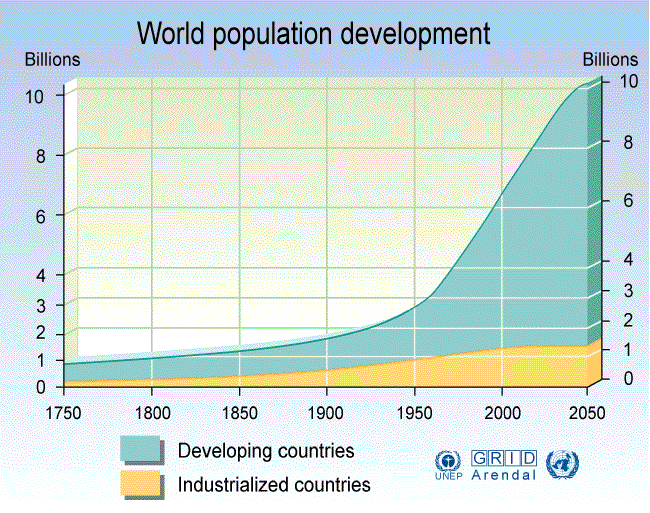We are the 7 billion
This post contributed by Liza Lester, ESA communications officer
At midnight, Manila time, on October 31st, UN officials welcomed Danica May Camacho of the Philippines as the world’s 7-billionth person, a symbolic baby for the symbolic Halloween “Day of 7 Billion.”
The LA Times led that morning with the steep population growth curve, forecast to pass 9 billion in 2045. The BBC emphasized that population growth is not just a problem of the developing world. “The UK population, one of the highest consumers of resources, is also expected to grow,” says the correspondent, adding gloomily that “Population control is controversial, but without it, experts say the future, for all of us, will be worse.” The Washington Post ran a scary story about our population growing…too old.
Can we be both too many and few? It depends on your point of view. In the U.S., Europe, Japan and China, women are having fewer children than necessary to keep the population growing. This is a problem for economies organized around growth. Europe and the U.S. are feeling the strain as the children of the post-WWII baby boom enter retirement. But too many young people can also create social strain. Southwest Asia’s baby boomers are under 30, and many are unemployed. The demographic disharmony may contribute to cultural upheaval. The difference in the U.S.’s fertility rate of 1.6 and our growth rate of 3.3 is made up in immigration — a controversial topic to say the least.
 Populations are relocating, becoming more urban. In 2008, the balance of the world population tipped from rural to city-dwelling. The world has 21 megacities of more than a million people, compared to the three that existed when the dystopian visions of Logan’s Run, Soylent Green and Blade Runner projected public fears of overcrowding on the big screen. Apocalyptic disease and weather have displaced midcentury fears of apocalyptic overpopulation at the movies. But the image of the crowded city remains a staple of overpopulation fears in the public imagination. The efficiencies of apartments, mass transit and shared infrastructure, however, lighten the footprints of urban humans, as well as contain them to a smaller area. Is space the problem?
Populations are relocating, becoming more urban. In 2008, the balance of the world population tipped from rural to city-dwelling. The world has 21 megacities of more than a million people, compared to the three that existed when the dystopian visions of Logan’s Run, Soylent Green and Blade Runner projected public fears of overcrowding on the big screen. Apocalyptic disease and weather have displaced midcentury fears of apocalyptic overpopulation at the movies. But the image of the crowded city remains a staple of overpopulation fears in the public imagination. The efficiencies of apartments, mass transit and shared infrastructure, however, lighten the footprints of urban humans, as well as contain them to a smaller area. Is space the problem?
Since the 70s, environmental groups have moved away from talking about population. Asked about the “taboo” at panel at the Woodrow Wilson Center on Tuesday, Kate Sheppard said she thinks a sensitivity to reproductive rights intervened. Sheppard covers energy, environment and reproductive politics for Mother Jones magazine.
 The story in the ‘70s had a heavy component of “other people should stop having so many babies,” she said. Now we are talking about resource use and distribution, access to knowledge about health, and women’s control of their own fertility. Developing countries have a lot of children, but use far less water, energy and other materials per person than the population of the U.S.
The story in the ‘70s had a heavy component of “other people should stop having so many babies,” she said. Now we are talking about resource use and distribution, access to knowledge about health, and women’s control of their own fertility. Developing countries have a lot of children, but use far less water, energy and other materials per person than the population of the U.S.
Girl power is the image that sums up a year of special reports on population for Wilson panelist Dennis Dimick, environment editor at National Geographic. “What choices will the women of the developing world have over the next decades?”
Women who go to school get married later, earn more, and invest in fewer children. Do women have fewer children because they are wealthy and educated, or are they wealthy and educated because they have fewer children? We don’t know. But it isn’t only in developed countries that we see the phenomenon. Though average yearly income in southern Indian state of Kerala is less than $300, the fertility rate is below replacement, and literacy is nearly 100%. It is a striking contrast to northern states like Bihar and Uttar Pradesh that, with women’s literacy below 60% and fertility rates close to 4, have India on track to steal the title of world’s most populous nation from China by 2025.
Andrew Revkin’s New York Times blog Dot Earth (which, rather interestingly, formally moved from ‘news’ to ‘opinion’ in 2010) regularly covers the demands of 7 billion humans on the resources of our singular, finite planet. Revkin met the Day of 7 Billion with the success story of a woman in densely populated northern Ethiopia who has gained the knowledge to bear and feed 11 children — and no more. “I’m beautiful, my husband can’t keep off me. But now I have the knowledge – and am using family planning. If it wasn’t for family planning I would have had 3 or 5 additional children,” she said.
Kerala’s successes and the general downward trend of fertility worldwide have been held up as counter-examples to top-down, compulsory population control like China’s ruthless one-child policy. But the idea still comes up. Though the birth-rate is down, Kerala’s coasts are heavily populated. In September, Justice V.R. Krishna Iyer, head of the Commission on Rights and Welfare of Women and Children, recommended oppressive laws to enforce a maximum of two children per family in the state.
Voluntary contraception is a touchy subject as well, and another reason that environmental groups shy away from conversations about population. “There’s a huge atmosphere of intimidation. The moment you say ‘family planning,’ immediately somebody pulls out abortion,” Carl Pope, chairman of the Sierra Club, told Mireya Navarro of the New York Times on Monday.
The Catholic Church in Kerala responded to Judge Iyer’s heavy-handed proposal with an “a large family is a happy family” campaign (modeled on the state “a small family is a happy family” slogan). “For the Catholic Church, population is still destiny,” said panelist Jon Sawyer, director of the Pulitzer Center on Crisis Reporting, just back from two weeks in India. But fears of being overtaken by more fruitful neighbors are shared by proponents of family planning as well, and emerge as anxiety over security cultural identity.
Panelist Heather D’Agnes of USAID agreed with Sheppard that we should address population in the context of consumption and not blame the world’s resource problems on the habits of other cultures.. She said that in California, for example, discussions about population growth easily turn into ugly diatribes about immigration. The problem isn’t that people are moving to the U.S. , it’s that they are moving and learning to live like us, Sheppard chimed in. We are afraid that our lifestyle is spreading around the globe and that all those other people will want us to share.
Some environmental groups are charging back into the population melee. Amy Harwood, Human Overpopulation Organizer at Tucson’s Center for Biological Diversity, weighed in on Revkin’s Dot Earth post to say that population is the ultimate pressure on Earth’s ecology.
“One thing that has not shown up in the many articles covering the Day of 7 Billion has been the connection population growth has on plant and animal biodiversity. With the world population reaching 7 billion people today, the global extinction crisis for animals and plants imperiled by overpopulation’s effects on habitat, water, air and other natural resources has been accelerated,” she wrote.
Ecologists are also speaking up about population and the challenge of feeding 9 billion humans without tremendous and irreparable losses to other species. How much wild land is left that could be put into food production? Not much. Can we get more out of the farmland we have? Will human diets have to change? Can education and the kind of bottom-up economic pressures that changed childbirth rates also change our habits of consumption?
7 Billion, National Geographic Magazine
*Graphic credit: Philippe Rekacewicz, UNEP/GRID-Arendal
